Part of prepping is being ready to pick up the pieces and put it all back together. Another part of prepping is being able to make what you need if you don’t want to do without.
Considering that so many of the disasters and other crises we are preparing for will entail natural and man-made forces more than capable of tearing up our homes and our towns, it is up to us to be ready to don our tool belts, heft our hammers and get busy repairing the damage that has been done.
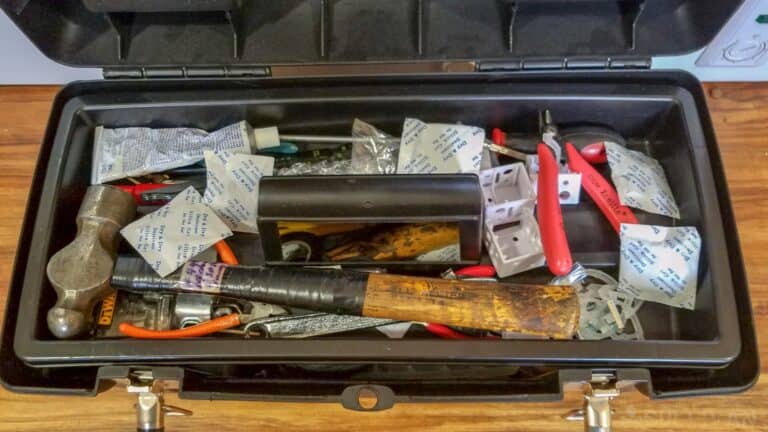
There won’t be anything worse than being completely unable to repair damage done to our homes, vehicles and equipment due to the lack of tools and a lack of skill. Lots of situations are recoverable if you have the right tools and know what you’re doing.
Having a roll of duct tape and prayers will only take you so far. If you want to get repairs or hasty construction done quickly and efficiently you’ll need a good collection of tools.
In this article I’ll provide you with that list of tools for the ultimate home toolkit to help you survive disasters and make it through emergencies in good repair.
Damage Control
There’s a sort of a default idea in prepping that we will always flee ahead of an encroaching disaster, or in the immediate aftermath after the sound and fury has subsided.
While escape when plausible is a dependable idea, it will not always be the right choice, or even a viable one. The situation at large will get a vote in the outcome. Escape may be frankly impossible, or too risky depending on the time table of the event and a whole host of other factors.
It bears repeating that your best chances for long-term survival may come from sticking things out right where you are. Home-field advantage is a thing.
It stands to reason that you’ll know the terrain intimately in and around your home and the surrounding area. If you have your home stocked to the rafters with supplies, equipment and more survival accoutrement it might make a perfect home base for riding things out.
What’s more, if you have neighbors, friends, family and other people that might make for a baked-in survival group your home may become the “fortress redoubt” of your survival efforts.
That is quite an asset! Is that something that you should abandon or resign to its fate just because it gets damaged by a disaster? I would argue no.
Your home is your survival shelter and worth repairing in any event it is damaged. Assuming, of course, it is repairable and safe to inhabit.
Anyone can grab a tarp, a roll of duct tape and some twine and try to cover a hole in the roof as best they may, but only someone skilled in construction and repair can close up that hole effectively and sturdily enough for the long haul.
Your survival tool kit will help you do that.
Build It or Do Without
Long-term survival situations will see you need all kinds of things that you didn’t prepare for or that you used up and wore out already during your odyssey.
Everything from an outdoor slit trench toilet and accompanying privacy screen to a clothesline for doing the laundry to improvised barricades to help keep invaders out and obstacles to keep them in optimum firing range a little longer. There is just no telling what you’ll need to build.
Even mundane things like a garden will require specialized tools if you want to get the land ready for planting and harvesting efficiently and with minimal effort.
You will need to construct fencing to keep out critters and trellises for certain climbing plants. Heck, you might even need to whip together a scarecrow to keep the birds away. Raised beds for planting are another common permaculture fixture any prepper should know how to build.
Is it possible to do all of the above using only improvised tools or raw manpower? Of course it is, but it is slow, laborious and prone to being screwed-up if you aren’t using proper tools.
A Note on Power Tools
You’ll note that there are no power tools on the list below. That is done with a purpose.
While power tools, especially those that run on gasoline, afford you incredible advantages in output and efficiency, they’re entirely dependent on either electricity or a chemical fuel to operate. That makes their long-term viability suspect compared to manual tools.
This is not to say that you should not make use of power tools, as several of them, chainsaws foremost, get work done at a speed that no manual tool can rival.
But if you do plan to make use of power tools it should be for comparatively short-term disasters in situations where the logistics of keeping them running is less of a detriment.
Remember: if you are dealing with a long-term or indefinite survival situation, something like a societal collapse as a result of a national or global event, power tools will become less and less viable.
But on that note, electric power tools may be more sustainable than their gasoline-powered brethren.
Portable and home solar systems are increasingly powerful and efficient, and more than capable of charging even the high-density lithium batteries used by cordless electric power tools.
You obviously have to make a substantial investment in your own off-grid power supply but it is something to consider for those who have already done so.

The Ultimate Home Toolkit for Survival and Emergencies
Disclosure: This post has links to 3rd party websites, so I may get a commission if you buy through those links. Survival Sullivan is a participant in the Amazon Services LLC Associates Program. As an Amazon Associate, I earn from qualifying purchases. See my full disclosure for more.
The following tools will form the core of almost any disaster-readiness repair and building kit. The focus is on adaptability and flexibility, not specialization.
This is not to say you shouldn’t include more specialized tools in your kit, but if you are purchasing tools to add to your collection I would not branch out into other tools before checking off the basics.
1. Claw Hammer, Carpenter’s
Every tool collection begins with a good, sturdy carpenter’s hammer. Aside from its obvious uses for driving and pulling nails, you can use your carpenter’s hammer for light demolition work, shifting stuck loads and pounding things into shape.
If you are skilled with a hammer you don’t need a heavy one to drive nails, but for those who didn’t earn their living roofing for a few summers, a heavier hammer (16oz-20oz) will help make shorter work of nailing and also affords you more power for demolition.
Make sure you pick one with a straight claw as opposed to a curved claw. Also investing in one with a shock-absorbing rubber handle, so long as it is quality, is a good idea.
2. Handsaw
Your number two tool should be an all-purpose, toolbox-sized handsaw. Occasionally referred to as a handyman’s or toolbox saw, these short, aggressive hand saws cut on both the push and the pull stroke to make quick if rough work of the task at hand.
These are just as at home cutting lumber as they are branches and once you get the rhythm down pat you can get a lot of sawing done with surprisingly little expenditure of energy.
Also I’ll give you bonus points if you learn how to sharpen a handsaw yourself, since doing so will give one a shockingly long life.
3. Axe
No prepper should be without a full size felling axe or camp axe. Used with care and skill you can easily bring down even large trees with one and their utility for limbing and bucking the resulting log is obvious.
Axes can also work well for splitting firewood, though this task is better left to mauls. More than most tools, axes will not suffer fools lightly and you should take the opportunity to practice with your axe whenever you can so you aren’t facing a lot of chopping when you are rusty. Not for nothing, an axe makes an extremely formidable weapon in a pinch.
4. Splitting Maul
Unless you live in a place without trees or live in a blasted, screaming hot hellscape where you would never dream of building a fire, make sure you have a splitting maul in your tool collection.
Compared to axes, splitting mauls have an even blunter edge and are easily identified by their thick broadly tapering heads, which leverage physics to split firewood apart as easily as you please.
Note that the two are not interchangeable, and mauls are very clumsy when used for other chopping tasks. But used together, and in tandem, almost nothing will make lighter work of a pile of firewood that needs processing.
5. Sledgehammer
A sturdy sledgehammer is an obvious choice for demolition and is also handy for extrication work, either from buildings that are damaged or vehicles.
Sledgehammers also get the job done when it’s time to drive posts or poles into the ground, and are also handy for busting up brick, concrete and other masonry. A sledgehammer can be used with a standard wedge to split wood and even whole trees, also.
6. Shovel (Spade)
You always get plenty of use out of a shovel, so make sure you get a good one. You’ll use your shovel for burying or digging up caches, digging a slit trench to make an outdoor toilet, filling sandbags or earth bags, creating fighting positions and digging pits for fires or refuse. The list goes on.
When choosing a shovel, you’ll typically have an option between a fiberglass handle and a traditional wooden one. The fiberglass handles will last a long time and are virtually unbreakable, but when they do break it can make it tough to re-handle the shovel.
It is a simple affair to stick a new wooden handle on a shovel if the original breaks.
7. Screwdrivers
There will always be screws that need tightening or loosening either for maintenance or for whatever project you’re constructing. For your emergency toolkit I highly recommend you get a set of various individual Phillips, flat and torx screwdrivers.
Specifically, do not get the ones with the interchangeable bits that fit into a universal handle. The bits are too easy to lose and break. Ultimately, if you break or lose the handle itself you will be out an entire set of screwdrivers…
8. Wrench Set
For the same reason you want a good set of screwdrivers you want a correspondingly good set of wrenches, and a variety at that. Crescent, box, open-ended, all kinds.
Wrenches really come in handy when working on engines and other machines but also earn their keep when you’re doing some heavy-duty fastening with bolts and nuts.
If you have the skills, it is worth investing in a mechanic’s wrench set that will let you perform all kinds of major operations and repairs on your automobile.
9. Ratchets and Sockets
Ratchets and sockets go with wrenches like peanut butter goes with jelly. If you have one, you probably really want the other, too.
A socket and ratchet set with ¼” and ½” drives covering the major imperial and metric sizes is more than adequate for most preppers, but similar to wrenches above if you have specialist mechanic and technical skills you might invest in a more comprehensive set.
You don’t need to go crazy with the giant rolling Stack-On chest set unless you already have it, but they can definitely make the difference between a fast, easy repair on an engine and a frustrating nightmare of a task.
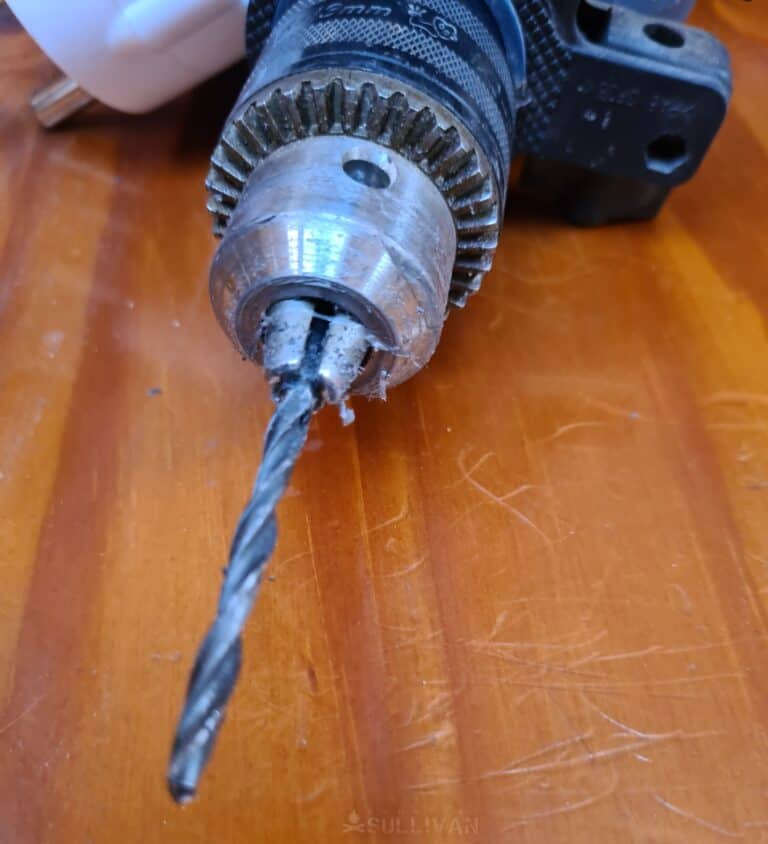
10. Hand Drill
Hand drills are seen as something of an anachronism today, but in a world without reliable electricity they’re about the only game in town for making clean, concentric holes in wood or metal.
Most examples have a chuck just like you would see on a standard electric drill and accept all the same bits.
Be aware that certain styles of bit, spade bits in particular, will not work well, since they cannot generate nearly as much torque as an electric drill. Nonetheless for making holes in wood or softer, thinner metals these are the ticket.
11. Pipe Wrench
When you run into plumbing problems, you’ll need a pipe wrench. Only pipe wrenches have the jaw span and the grip to wrangle otherwise slippery plumbing pipes.
I have probably seen more botched jobs on account of lacking a pipe wrench than any other tool when it comes to DIY plumbing repair.
Even if your house uses the latest in PVC or PEX piping, make sure you nab one of these. It might not be your house that can make use of it, and they are always handy for wrangling metal tubing and conduit of different kinds.
12. Vise Grips
The first in the holy triumvirate of the quick-and-dirty toolkit. Vise grips can function as a clamp, as pliers, as a wrench and more in a pinch. The finely adjustable and lockable jaws will bite down tightly on any recalcitrant fastener they can fit on.
While highly aggressive and notorious for rounding off nuts, these are an extremely handy do-all tool that belongs in your BOB and in your toolkit both.
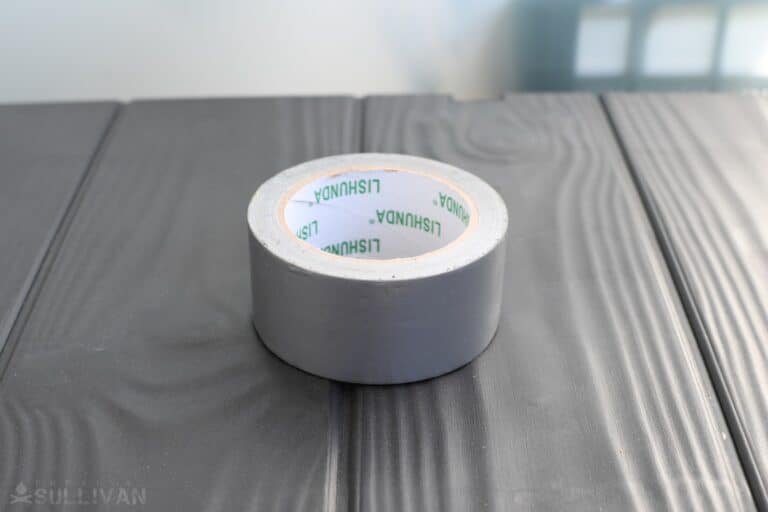
13. Duct Tape
The one tool that all preppers love, and the second in the holy triumvirate of the quick-and-dirty tool kit. Duct tape has a thousand and one uses, and is extremely handy for sealing, fastening, lashing and other improvised repairs.
One roll of duct tape can seal off a room or a house to prevent the ingress of contaminated air, plug holes in fabric or shingles and securely bind two or more things together.
You’ll never run out of uses for duct tape, and you want to make sure you don’t run out of it! Stock up now, buy it cheap and stack it deep. On that note, it pays to get the good stuff.
More expensive “designer” duct tapes have dramatically thicker fabric backing and far stickier adhesive that will last through rain and shine. Spring for the good stuff for your emergency tool kit!
14. Spray Lubricant (WD40, et al.)
An essential resident for any toolbox and the third member of the holy triumvirate of the quick-and-dirty tool kit is the spray lubricant.
Every machine, even the simplest, needs lubricant to prevent malfunctions and to ensure a long life span. Your first step when anything stops moving (that should be moving) is to lubricate it.
A quick shot of lube and you’ll usually see the thing that stopped working start working again at once. Thin penetrating lubricants also work wonders for loosening stuck bolts and screws, and can make repair or salvage operations a far sight easier.
15. Files
A set of medium and large files of various shapes and profiles will let you rework and reshape metal, removing burrs or sharp edges while helping slightly oversized parts fit snuggly and easily.
Files are also the tool of choice for doing the opposite: putting a wicked point on a metal rod or sharpening edges and blades on all kinds of other metal tools like axes, machetes, mauls and even shovels.
16. Rasps
Rasps are sort of a counterpart to files, only these are intended for working on wood, not metal. Rasps are extremely handy for shaping and profiling wood, and can help you clean up pieces that were more roughly cut by faster tools.
They also work gangbusters for generating fine shavings that are useful as tinder for fire starting.
17. Chisels, Wood
Chisels are handy for carving out furrows in wood and also for creating all kinds of joinery. If you need to make or repair furniture in a long-term survival situation (among many other things), or precisely fit two or more pieces of wood together, chisels are going to help you make that happen.
Make sure you keep your chisels sharp: if you don’t know how, learn how before the time comes to sharpen them as they are easily ruined by hapless sharpening.
18. Miter Box
A miter box is a plastic or metal box used to hold various sizes of wood or other stock for cutting off at various angles. This is accomplished by a variety of preset slots that your hand saw will fit into for accuracy.
While obviously not as fast or efficient as a power miter saw, this is a no electricity alternative that works well and is far more accurate and consistent than trying to cut these angles free hand or using guides. This can be a great help for roofing work and other construction.
19. Metal Snips
Sometimes known as aircraft shears, sheet metal snips will help you cut through all kinds of thin ductile metals commonly found in siding, roofing and automobile body work.
Note that there are a couple of kinds, those designed for straight cuts and those designed for making circular cuts.
The circular cut-models are further divided into so-called right-hand and left-hand versions which are designed to make clockwise or counterclockwise cuts as they move through the material. It is often worthwhile to have a set of each to cover all your bases.
20. Tarps
Tarps are your first line of defense when you need to cover up large holes in roofs or walls to keep out wind and water.
They also work well as a ground cover, as a temporary water catching system and for improvising shelter.
Any tarp that you select should have heavy duty grommets that can stand up to a substantial load and should also be made out of lightweight but sturdy material for durability.
Ideally, any tarp will be completely water impermeable. Make sure you have several of these and take good care of them. You’ll need them.
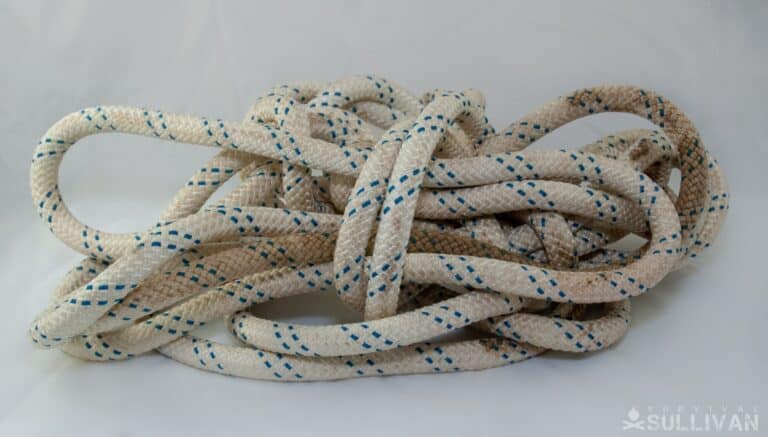
21. Cordage and Rope
Strong cordage and sturdy rope are two more tools that all preppers love. From securing and hauling loads, hoisting heavy things, creating lanyards, attaching tarps, hanging animal carcasses and clamping work pieces you’ll depend on cord and rope all the time.
It pays to know a bunch of working knots so that you can get the most work out of your cordage and rope. You should invest in several different sizes to handle any variety of tasks that you might encounter.
Small, thin twine is useful for layout and light-duty chores while heavy-duty rope is just the ticket for hoisting heavy loads. The go-to prepper favorite is paracord, loved for its unbeatable combination of small-diameter, flexibility and immense strength for its size.
24. Plastic Sheeting
Large rolls of heavy mil plastic sheeting will get all kinds of use in the aftermath of a disaster. From sanitation and waste collection to roof repair and water catching, plastic sheeting gets it done.
One of plastic sheeting’s best uses is for sealing off your windows and doors to prevent air infiltration in the event you are dealing with a tainted atmosphere from chemical, biological or radiological hazards.
You can also use plastic sheeting for mundane chores like keeping your vehicle or your interior floors free of contamination by muck, mud and grime.
23. Fasteners
No matter what kind of repair or construction project you are working on, you’re going to need fasteners unless you want to rely strictly on conventional joinery and duct tape.
You will need a good supply of all kinds of nails in various sizes and lengths, corresponding types of screws for both wood and metal.
You’ll also need an assortment of machine screws for replacements in various gadgets and pieces of gear, and organized, easy-to-access supplies of nuts and bolts for almost any situation along with washers, pins and other assorted bits and bobs.
24. Bench Vise
A heavy-duty clamp-on or bolt-on bench vise will serve as a wonderfully helpful set of extra hands for all kinds of projects.
A vise is also the tool to beat when you have to put some serious clamping pressure on anything you are working on, and can be useful for bending and straightening, peening and other tasks.
25. Construction Adhesive w/ Grease Gun
Construction adhesive will be valuable in all kinds of ad hoc repairs and construction projects that you want to last when you are done.
Used in tandem with screws, nails or other fasteners, construction adhesive will drastically increase the strength of your creations, a worthwhile upgrade for next to no effort.
Make sure you have a few tubes that are unopened and ready-to-use for emergencies, and also keep an eye on their expiration date if they have one.
This stuff does not last forever sitting on a shelf, and also goes bad pretty quickly after it has been opened, no matter how you might try to seal it.
26. Expanding Foam
This nasty, sticky stuff is just what the doctor ordered when you need to stop a draft, plug a hole or keep pests out.
For plugging small holes and cracks or large ones, expanding foam could not be easier to use; just pull the tab, insert the nozzle, squeeze the trigger and watch that yellow stuff grow and grow.
You’ll find more uses for this goop than you think around the house in the aftermath of a disaster, and when you can no longer rely on air conditioning or a furnace to climate control your home, you’ll get really serious about keeping drafts down to a minimum.
27. Air Pump, Manual
A high-quality manual air pump will allow you to fill up everything from bicycle and motorcycle tires to car and truck tires, though the latter two will be quite the job indeed.
Still, when you can’t count on electrical or gasoline powered air compressors, you’ll need a way to air those tires up one way or the other and that means you’d better have an air pump that can do the job.
28. Ladder
For clambering atop your house’s roof, reaching broken and questionable branches that are ready to come down or doing anything else that sees you working above the ground. You can find plenty on Amazon.
29. Electrician’s Tool
This combination stripper, cutter and crimper comes in very handy if you need to work on any electronic devices that you managed to keep running during a long-term disaster.
True, you can make do with a knife or other similar tools, but this one works well enough and is small enough to make it a valuable “just in case” member of every toolbox.
30. Tool Bag / Toolbox
There’s hardly anything more frustrating than carrying around an arm load of awkward, heavy tools from worksite to worksite or project to project.
Save yourself from this irritation and speed up your workflow by using a tool bag with a variety of pouches, pockets and holders for all the tools you’ll need for a given job.
Also, tools have the seemingly magical ability to vanish if they are not put back after you are done using them, so if you do nothing else but keep your tools inside a dedicated tool bag or tool box you will ensure they are always there when you need them.
31. Tape Measure
If you plan on building anything then following the wisdom of many construction sites will tell you that you need at least one tape measure. It’ll help you measure things for home repairs, and is a great addition to your tool set.
32. Level
More important than any insurance policies you can buy, a level will make sure your house or any project is sound and straight.
If you plan on having any home tool kit for building you would be remiss if you didn’t have a level with you.
33. Solar or Hand-Crank Flashlights
Most people shy away from flashlights since they require extra batteries but if you invest in a solar flashlight you can use the power of the sun.
Flashlights are great for seeing in tight spaces and in the case natural disasters such as an earthquake can help you search through rubble or debris
34. Thick Work Gloves
Gloves are essential for anything from handling rusty metal to cutting something with a utility knife.
The versatility in using work gloves is that you can handle many things that could potentially harm your hands. This includes moving wood in a fire, handling hot objects and even processing games.
35. First Aid Kit
Always have a first aid kit in your possessions because you never know when you’re going to need some medical aid.
It could be filled with gauze, antiseptic wipes, tweezers, pain relievers such as aspirin, and antibiotic ointment. Anything medical you might think you’ll need for your family’s needs.
Honorable Mentions
There are a few tools that are either specialized enough or situationally specific enough that they are not quite auto-includes for all preppers, but they are nonetheless handy and useful enough in their intended niche that they are worth serious consideration.
Post Hole Diggers
Depending on who you ask this tool is either a godsend or one of the devil’s own infernal contraptions. In the right soil, these will help you quickly and comparatively easily make a bunch of properly sized holes for sinking fence posts in the ground.
In too-hard or rocky soil, all it will give you is blisters and teach the younger ones in your survival group a few new curse words. If erecting fencing is something that might be on your agenda post-SHTF, you should consider including a set of these in your survival toolkit.
Hoe
Anything that you can do with a hoe you can do nearly as easily with a shovel when it comes to gardening. Even so, for large-scale gardening the efficiency bonus given to you by a hoe may make it worth it.
Hoes are so cheap and so ubiquitous, you probably already have one of these gardening implements right now.
If you don’t, and are considering gardening and other permaculture as long-term survival strategies, consider picking one up now and getting in a little gardening practice before things go really pear-shaped.
Scythe
By far the most archaic tool on this list and one that is more associated with Halloween and mythological depictions of Death than as any kind of practical tool that still has use today.
That being said, you would be wrong about this ancient reaping tool! A good scythe, properly adjusted to its user, is a surprisingly efficient tool for the cutting of grass and crops.
On flat, level ground a scythe can trim your yard up ship shape and in no time.
Cutting the grass isn’t just the stuff of kind society in normal times, as keeping grass and other foliage trimmed back will help minimize infiltration by pests and keep people from sneaking up on you on unobserved.
But if you live on sloping, rocky or grassless terrain, or you aren’t planning on growing any crops, a scythe will be less than useless.
Conclusion
You can scavenge and improvise a lot that you might need in the aftermath of disaster, but having a properly outfitted toolkit will only increase your chances of successful repairs, DIY construction and countless other projects.
You really don’t need that many tools to be prepared for the vast majority of problems and tasks that you are likely to encounter in a SHTF survival situation. Use this list and start building out your ultimate home survival tool kit today.
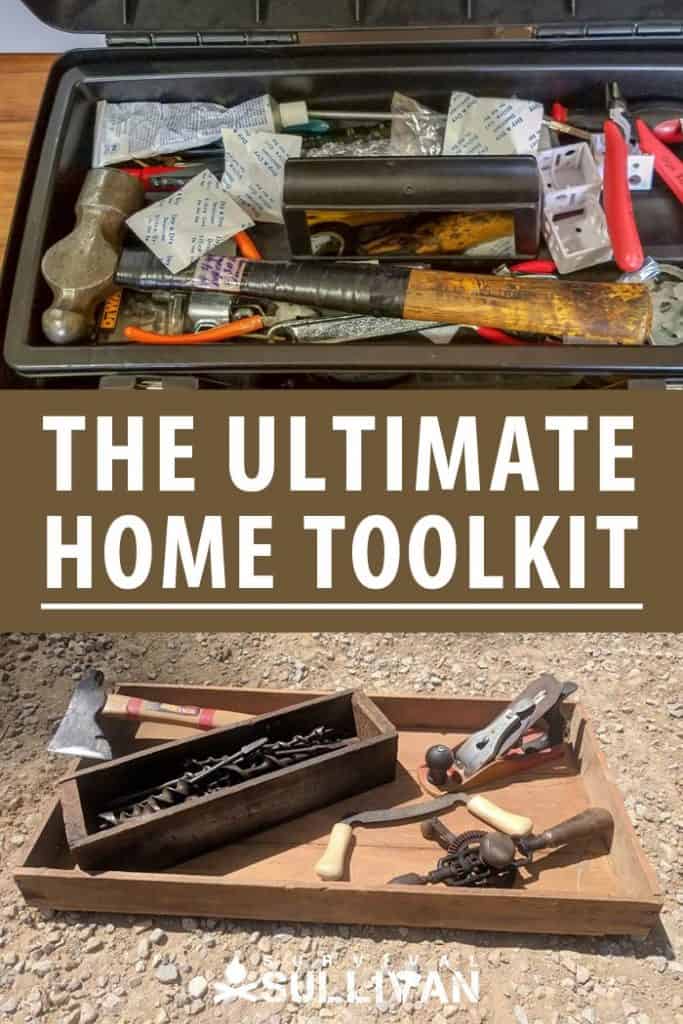

Tom Marlowe practically grew up with a gun in his hand, and has held all kinds of jobs in the gun industry: range safety, sales, instruction and consulting, Tom has the experience to help civilian shooters figure out what will work best for them.

if you don’t include clamps >>> everything from the cheapie plastic spring clamps to an infinite length expandable 3/4″ black pipe bar clamp <<<< they are the lone repair guy's 3rd hand
Other tools to consider
Mattock
Draw Knife
Block Plane
Sand Paper of various grits
GoJo or other waterless hand cleaner